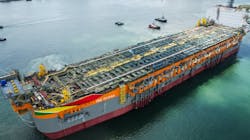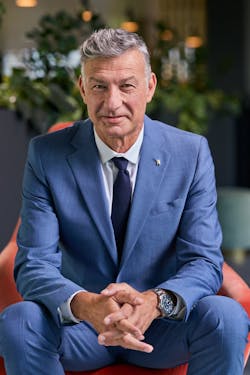By Ariana Hurtado, Editor-in-Chief
Over the past six to 12 months, the industry has seen a number of FPSO newbuilds and conversion projects underway.
According to research by Mark J. Kaiser with Louisiana State University, the number of active and available FPSOs worldwide hit its peak from 2016 to 2020 at about 195 to 200. Today, he says, there are 183 active and available units. Of the 166 active units, about 58% (96) are conversions, 34% (56) are newbuilds and 8% (14) are redeployments.
"After an award is made, shipyards begin the construction or upgrading process, which may take between two to five years or more to complete," Kaiser reported. "Upon completion, units enter service, either by newbuild or conversion pathways."
Newbuilds
Constructed by SBM Offshore, the ONE GUYANA FPSO newbuild reached offshore Guyana on April 15. Exxon Mobil says this is Guyana’s fourth FPSO to operate in the Yellowtail Field development with initial production capacity of 250,000 bbl/d. This vessel joins the Destiny, Unity and Prosperity FPSOs in the Stabroek Block.
In addition, SBM Offshore completed project financing last November of the Jaguar FPSO for the Whiptail development offshore Guyana for $1.5 billion. The company secured support from a consortium of 16 international financial institutions and expects to draw the loan in phases over the platform’s construction period. The Jaguar FPSO will feature SBM Offshore’s seventh newbuild Fast4Ward multi-purpose floater hull with various standardized topsides modules. It is designed to produce 250,000 bbl/d of oil, with 2 MMbbl crude storage, associated gas treatment capacity of 540 MMcf/d and water injection of 300,000 bbl/d. The vessel will be spread moored in a water depth of about 1,630 m.
SBM Offshore also designed and constructed the Almirante Tamandaré FPSO, which reached its offshore destination at the Búzios field in the Santos Basin offshore Brazil in October 2024.
As for the offshore Brazil region, Shell signed a purchase and sales agreement in late March with MODEC for a newbuild FPSO for the Gato do Mato Field development in the Santos Basin. The Gato do Mato FPSO, designed to produce 120,000 bbl/d of oil and associated gas and water, will be spread moored in about 2,000 m of water, 200 km south of Rio de Janeiro. MODEC will perform the design of the hull and all related topsides facilities, with SOFEC responsible for the mooring system. Gato do Mato will be the company’s 19th FPSO for the Brazilian sector and its second for a Shell project offshore Brazil. First oil is expected in 2029.
Moreover, Petrobras recently reportedly that it has increased its offshore E&P capex budget to $73.5 billion through the end of 2028. The company plans to have 14 additional FPSOs in place by 2028 and intends to drill 50 new wells by the end of that year.
Conversions
"Units available for conversion compete with newbuilds on price and schedule," according to Kaiser.
Drydocks World opened its new South Yard expansion in late December. The 75,000-sq-m facility increases the site’s fabrication capacity by 40% and yard capacity by 25%. The ship repair company says it made the investment to enable it to execute multiple large-scale projects at the same time, including FPSO conversions, among other things.
Offshore Australia, Carnarvon Energy CEO Philip Huizenga told Offshore last year, "The [Dorado] joint venture has been exploring and assessing FPSO vessel conversion and redeployment options that could further bring down capital expenditure below the original US$2 billion guidance, and put Carnarvon in a position to fully fund its 10% share of the development."
Offshore Angola, TotalEnergies and partners Petronas and Sonangol took FID in May 2024 on the Kaminho oil project in Block 20/11. It will be the first large-scale deepwater development in the Kwanza Basin, producing the Cameia and Golfinho fields in 1,700 m water depth, located 100 km offshore. It will also be TotalEnergies’ seventh FPSO to operate in Angolan waters.
At the time, Petronas said plans call for conversion of a very large crude carrier to an FPSO, which will be connected to a subsea production network. To minimize emissions, the platform will be all-electric and the associated gas will be fully reinjected into the reservoirs, so there will be no routine flaring.
TotalEnergies said it expects production to start in 2028, peaking at 70,000 bbl/d. The company awarded Saipem three of the main contracts, with a combined value of $3.7 billion. The first covers engineering, procurement, construction, transportation and commissioning of the FPSO. Under the second contract, Saipem will provide operation and maintenance of the vessel for 12 years with potential for an eight-year extension, drawing on its experience from three other FPSOs currently operating in Angola. The third contract is for the engineering, procurement, supply, construction, installation, pre-commissioning and assistance for commissioning/startup of a SURF package.
The initial stages of the conversion included the dismantling of parts of the structure, which are being carried out by China Merchants Heavy Industry and Saipem. A ceremony held in China in April of this year marked the start on the conversion.
An executive's perspective
To gain some additional insights into this topic, Offshore recently chatted with Olivier Icyk, chief business officer with Dutch-based SBM Offshore, about FPSO market trends and demand, technological advancements, project management and execution, and strategic partnerships and collaborations.
Offshore: What regions are currently driving the most demand for FPSO projects, and why?
Icyk: The market outlook for deepwater FPSOs is promising, and our tendering pipeline remains strong. Over the next three years, we anticipate around 40 potential FPSO awards, with around 36% falling within our target market of large and complex FPSOs.
Ultradeepwater production is set to continue growing at a great speed to account for half of all deepwater production by 2030. Deepwater production remains the fastest-growing upstream oil and gas segment with production hitting 10.4 million boe/d in 2022 from just 300,000 barrels of oil equivalent per day (boe/d) in 1990. Promising prospects [are] in Brazil, Guyana, Suriname and Namibia and in the Atlantic basin in general.
Offshore: How are digitalization and automation impacting FPSO newbuilds and conversions?
Icyk: Digitalization is now everywhere. It is really changing our lives and the way we work. For us, the digital twin project, as we called it 10 years ago, was one of the foundational projects of our digital journey. We already have what we refer to as digital agents—digital programs that process and act on the data generated by our FPSOs—and we developed our own digital agents to perform tasks like abnormal behavior detection.
The basis of digitalization is your data structure and ability to scale up your digital solution quickly from asset to asset. We believe that by working with leading companies in that field, we have reached the right scalable data structure.
Sometimes, an anomaly might not indicate a significant issue; it could be a malfunctioning sensor or instrument, but the system enables thorough investigation. To mitigate potential risks, we also use agents to monitor factors like position, tensioning and environmental data. At the same time, we continue to expand our portfolio of digital agents to mine data effectively and ensure this data becomes readily available for our onshore teams as well.
Last year we were awarded the ABS Certification for Remote Con-Notation for Liza Unity. This capability allows the onshore team to see in real time all of the same FPSO topsides and package controls as the team working offshore on the FPSO.
Similarly, we have a robotics program, which is part of our technology initiatives. It’s focused on replacing activities that are potentially harmful to people offshore.
Every five years, the company needs to inspect and verify the integrity of various systems on vessels. These tasks often include activities such as tank cleaning, which necessitates personnel entering hazardous areas to carry out inspections. Instead of sending inspectors and third-party personnel offshore, we can send robots equipped with cameras and sensors to work. One obvious application is using robotics for tasks like inspecting large towers. Normally, you’d have to send people up 100 meters, but with robots equipped with drones, cameras and sensors, we can handle those inspections more efficiently and safely.
Lastly, in March 2025, we signed a strategic collaboration agreement with Microsoft to develop floating gas-fired power plants that could one day provide power for data centers. We will look at plants that generate electricity, have integrated carbon capture and storage, and utilize Microsoft’s artificial intelligence analytics. The first phase of the project will focus on situating the units in the UK and Norwegian waters.
Offshore: What measures are being taken to reduce the environmental footprint of FPSO units?
Icyk: Decarbonization of offshore operations is another interesting area, particularly when you look at broader ambitions for alternative fuels like ammonia or the carbon value chain. Decarbonization is one of our strategic priorities, and we are heavily committed to this approach.
We will explore and develop innovative solutions for deepwater ocean infrastructure in new and existing markets.
In the meantime, we have just got the AiP by ABS on our concept of a near zero FPSO unit. Part of SBM’s EmissionZERO program, the FPSO design incorporates low-carbon technologies that collectively create a 'near zero' Scope 3 carbon emissions profile, achieving up to 80% reduction in GHG emissions. The introduction of the NearZero FPSO is an important step in SBM’s strategic path to achieve net-zero emissions by 2050. ABS completed design reviews based on class and statutory requirements.
Additionally, just a couple of months ago, Liza Unity received the Sustain-2 Notation—the first FPSO to be the recipient of such an important award.
Offshore: Can you discuss any recent advancements in emissions reduction technologies for FPSOs?
Icyk: In February we announced the signature of a study with Petrobras for the application of carbon capture modules on FPSOs.
The module design is based on a successful engineering and design study between SBM Offshore and Mitsubishi Heavy Industries Ltd. (MHI), based on a combination of MHI’s proprietary CO2 capture technology and SBM Offshore’s Fast4ward principles. This compact modular solution allows a significant reduction of the overall emissions associated with the production of oil and gas from FPSOs. The solution is being developed as part of SBM Offshore’s EmissionZERO program.
In parallel, we partner with fabrication yards in China and Southeast asia, where we benefit from long-term relationships based on trust , which are certainly necessary to deliver these major capital projects.
We feel we are doing our very best to equip clients and companies with the best sustainable solutions.
Offshore: How do you ensure that projects stay on schedule and within budget, especially given the complexities of offshore construction?
Icyk: SBM Offshore's Fast4Ward program, which builds standardized FPSO hulls in anticipation, helps to significantly reduce project delivery timelines. The main schedule advantage comes from the pre-investment in the Multi Purpose Floater (MPF), which shortens the Fast4Ward FPSO project schedule by approximately nine to 12 months.
The Fast4Ward concept, developed in 2015, therefore focuses on standardization of the hull. Beyond that, rather than ‘macro standardization,’ smaller elements such structural components, modules layout and equipment are standardized. Within each customer’s requirements, further standardization is possible too, and SBM Offshore tends to use the same contractors, making gains in quality, timeliness and safety by standardizing their supply chain.
We capitalize on the performance of our projects and operations teams, which have executed more than 40 FPSO projects, and we benefit of return on experience of more than 400 years.
About the Author
Ariana Hurtado
Editor-in-Chief
With more than a decade of copy editing, project management and journalism experience, Ariana Hurtado is a seasoned managing editor born and raised in the energy capital of the world—Houston, Texas. She currently serves as editor-in-chief of Offshore, overseeing the editorial team, its content and the brand's growth from a digital perspective.
Utilizing her editorial expertise, she manages digital media for the Offshore team. She also helps create and oversee new special industry reports and revolutionizes existing supplements, while also contributing content to Offshore's magazine, newsletters and website as a copy editor and writer.
Prior to her current role, she served as Offshore's editor and director of special reports from April 2022 to December 2024. Before joining Offshore, she served as senior managing editor of publications with Hart Energy. Prior to her nearly nine years with Hart, she worked on the copy desk as a news editor at the Houston Chronicle.
She graduated magna cum laude with a bachelor's degree in journalism from the University of Houston.



